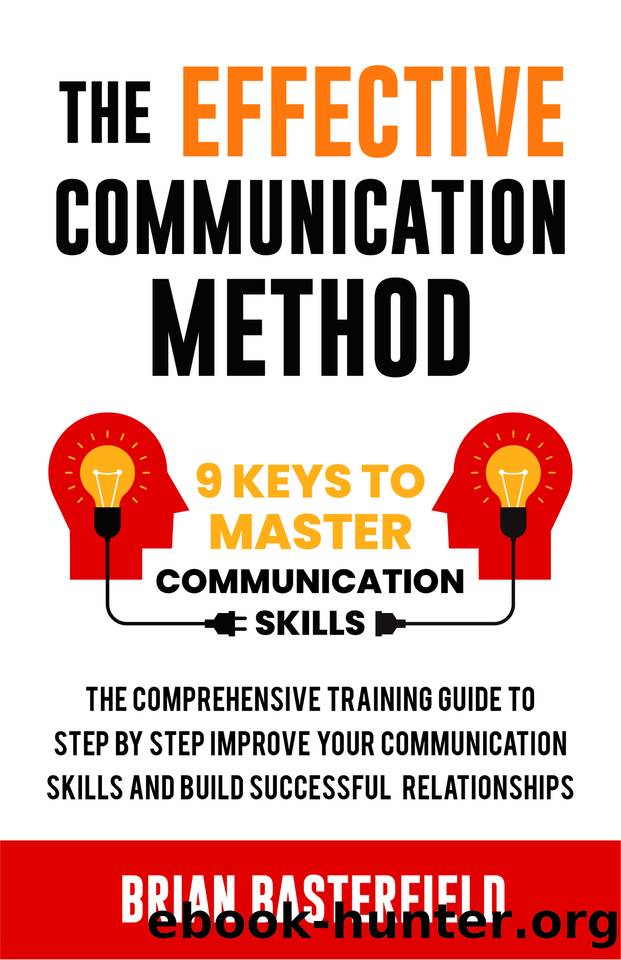The Effective Communication Method: 9 Keys to Mastering Skills, A Comprehensive Guide to Step-by-Step Improvement for Building Successful Relationships by Brian Basterfield

Author:Brian Basterfield [Basterfield, Brian]
Language: eng
Format: epub
Publisher: www.365selfgrowth.com
Published: 2023-03-04T00:00:00+00:00
TYPES OF UNSUPPORTIVE LANGUAGE
Sarcasm:
Sarcasm uses mockery to convey a message of contempt. The chosen words are meant to cut or sting the other person. It intentionally inflicts pain by ridiculing, taunting, or deriding the other person. Many people tend to hide behind such language calling it sharp wit, but it is cutting words meant to make the other person feel small.
Labeling:
Labeling language is meant to put others in a box and shame them into feeling inferior, either due to their history or decisions. You rely on information about the other person to label them negatively, which diminishes their abilities and capabilities.
Judgmental messages:
This is passing judgement on another person based on the very limited information that you may have. For example, you may refuse an employee a raise because they were late a few times, and you quickly judge them for their late coming without knowing the reason why. Maybe they have a long commute, no car to get to work, or a child to care for before heading to work.
In a meeting, you may single them out with phrases like âhere comes the perpetual latecomer,â which influences other employees, causing them to look at this particular employee in poor judgement. They may treat this employee poorly because of your judgmental message.
Threats:
Threats are unsupportive messages that make the other person feel unsafe and unwanted. To use threats means to use insulting and aggressive language, which tells the other person that you do not have their best interests at heart and donât care about their wellbeing.
Negative comparisons:
You do not typically use supportive language when you compare people negatively to others. For example, you tell your child, âLook at the smart decisions your sister makes, and why canât you be more like her?â You are breaking down the childâs sense of self-confidence and worth, so they feel like just being themselves is not enough; they have to be like someone else to be enough.
Download
This site does not store any files on its server. We only index and link to content provided by other sites. Please contact the content providers to delete copyright contents if any and email us, we'll remove relevant links or contents immediately.
Rewire Your Anxious Brain by Catherine M. Pittman(17600)
Talking to Strangers by Malcolm Gladwell(11909)
The Art of Thinking Clearly by Rolf Dobelli(8868)
Mindhunter: Inside the FBI's Elite Serial Crime Unit by John E. Douglas & Mark Olshaker(7850)
Becoming Supernatural by Dr. Joe Dispenza(7120)
Change Your Questions, Change Your Life by Marilee Adams(6658)
The Road Less Traveled by M. Scott Peck(6649)
Nudge - Improving Decisions about Health, Wealth, and Happiness by Thaler Sunstein(6643)
The Lost Art of Listening by Michael P. Nichols(6484)
Enlightenment Now: The Case for Reason, Science, Humanism, and Progress by Steven Pinker(6414)
Win Bigly by Scott Adams(6328)
Mastermind: How to Think Like Sherlock Holmes by Maria Konnikova(6251)
The Way of Zen by Alan W. Watts(5813)
Daring Greatly by Brene Brown(5652)
Grit by Angela Duckworth(4747)
Big Magic: Creative Living Beyond Fear by Elizabeth Gilbert(4736)
Men In Love by Nancy Friday(4342)
Flow by Mihaly Csikszentmihalyi(4062)
The Four Tendencies by Gretchen Rubin(4030)
